David D. Coleman, David A. Westcott CWNA Study Guide Fifth edition, Exam CWNA-107 Sybex, 2018
This book has been my companion since I started working in my employer’s entrerprise wireless LAN in late 2018. It’s a foundation guide that gave me the right approach to wifi networking and architecture. It’s also a technical reference guide for the many situations facing a WLAN administrator during the day to day operations of designing, deploying, validating and troubleshooting an enterprise WLAN.
Taking the CWNA exam was not my initial goal, as I just had a pressing need to understand WLAN networking. Later on the certification idea piqued my interest, I learned about CWNP and took the CWNA certification exam eventually in 2019.
Coleman and Westcott assume that the reader already has a good knowledge of networking, but they don’t take anything for granted: in this book every concept is introduced plainly and sometimes from the very basics, explaining the context where the 802.11 standard evolved and the problems it tried to answer.
That makes part of the book’s bulk (845 pages plus appendixes), and may seem too verbose for the more seasoned IT professionals; nonetheless, the summaries, indexes, tables of content and exam essentials list make it well organized, very usable text.

There’s a trove of diagrams and tables that I photocopied and are still hanging around in the office, plus many references to blogs, websites, videos and twitter accounts related to wifi. I opened a twitter account just for keeping up with wifi news and it’s been educating and fun.
The book starts with a 40-questions assessment test, each of the 20 chapters ends with a 20-question review section. The review questions check that you take home the essential points of each chapter: reading the answers to review questions will help you understand the finer points where you may have failed. Please note that the review questions are different from the exam questions in both kind, purpose and quality: it’s just an internal tool of the book.
The same review questions are available in an online learning environment on the Wiley website, accessible via registration (it’s free, but will ask few questions to make sure you purchased the book). Taking the review questions online you can choose to visualize the answers and explanation immediately, and this may be more convenient to some reader. But overall I was disappointed that it’s just the same questions from the book, in the same order, and no new ones.
This makes the final online assessment review on the Wiley site less useful and actually boring, at least to my personal learning style. To be honest, there is also a good Glossary of technical terms in pdf format, and an online flashcard generator which is great if that’s your learning style. The flashcards web page displays well on a phone, which is very practical.
The chapters from the table of contents I found most challenging and tough are:
Chapter 2, with the mind-boggling 802.11 alphabet soup, one of the most useful sections to review as I encountered the different amendments further in the book.
Chapter 4, which explains RF math, with a bit of humour.
Chapter 5, with its Fresnel zones, polar charts and VSWR.
Chapter 6 the first real tasty bite into spread spectrum technologies, modulation and coding, 2.4 and 5 Ghz bands and channels.
Medium access, MAC and MIMO (chapters 8, 9, 10) made also a very dense read for me, that’s where all the technical details, amendments and concepts fit together and start making sense.
The remaining chapters are a very educating read, broader in scope and devoted to the professional aspects of WLAN administration from design to validation.
If you study for the exam, check the CWNA-107 exam objectives in the introduction, the same which is available for download on the CWNP site, and the objectives-to-guide mapping.
There are very few typos in the book. The guide was clearly well edited and proofread from the publisher and from the authors, but a few points were missed: it’s minor stuff that it is easy to spot.
If you are preparing for the CWNA exam, should you buy this book or the other Official Study Guide by Tom Carpenter and Mitch Dickey, published by CertiTrek in 2017? The latter is shorter and more condensed, but as both refer to the same exam version (CWNA-107) it’s a matter of personal preference and experience.
I keep this book in my office and check it out from time to time as I study for my next CWNP certification.
Edited to add: Clear To Send podcast #138 features a lengthy interview with Coleman and Westcottt. They tell how the CWNA Study Guide was conceived and written, the different editions and how many copies were sold, and many other things.